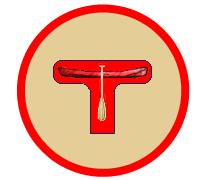

The gear list below describes what I took with me on a short - one night - winter camping trip in February. Our campsite was located about a 2-km snowshoe from the trailhead. For this trip a large 6-person canvas tent was to be already setup and therefore my list doesn't include a tent. This list also excludes food and food preparation and cleanup equipment such as a stove, pots, pans, dish soap, etc. which were already brought in via a toboggan days earlier.
The weather was expected to be fairly typical for near-north Ontario, approximately -10°C on the first day, -25°C at night and then warming up to -4°C on the second day.
Outerwear:
Stuff:


Toiletries:

To Wear:
Sleeping:
Extra clothing (just in case):
More thoughts on winter camping...
The biggest challenge in winter camping is of course keeping warm. And a big part of keeping warm is keeping dry.
The key is to keeping dry and warm is layering. Layering provides good insulation and allows you to remove or add layers as your level of activity changes. I prefer fleece to wool but the newer merino wools are quite soft and comfortable and have the advantage of not melting when hit with a spark from a camp fire. I still like fleece and fleece comes in so many different weights, styles and colours and is very inexpensive. No cotton clothing in cold weather - if it gets wet with melting snow or sweat it will stay wet and make you cold.
On my legs I usually wear 3 or 4 layers:
On my torso I usually wear 3 or 4 layers:
For my head I bring:
For my hands I usually have a thin fleece glove to facilitate picture taking and other tasks and a heavier lined wind-proof (leather, Gortex, or similar) glove for wearing when not very active.
For my feet I usually wear a thin sock with moisture wicking properties covered with a thicker wool sock and then a pair of Sorel-type boots with a removable liner (mine happen to be rated to -40C).
I always have a fresh set of expedition weight fleece underwear, fleece pants, fleece shirt(s), and warm socks for sleeping in. You don't want to sleep in clothes worn during the day as they are will be moist from sweating (even on the coldest of days). The key to staying warm is to keep dry and, even in your sleeping bag, layering.
** Bring an extra pair (or two) of socks and boots/liners. When the day's activities are over change into dry socks and put on dry boots. It will help keep you warm in less active periods of the day.
The removable liners in the boots are nice because they can be removed and the sweat dried out of them by holding them near the evening fire and they can be brought into your sleeping bag with you in the morning to warm them up before getting up in the morning.
During snowshoeing you should have a good sized day pack with you (40+ litres) to hold not only your water for the day, but also layers of clothing as you remove them during active periods. It's surprising how warm you can get just walking at a normal pace on snowshoes on a cold day.
Of course a good, warm sleeping bag is necessary at night. My old -7°C sleeping bag wasn't generally warm enough to keep me comfortable so I used to also wrap myself in a fleece blanket inside the sleeping bag and also wrap my feet in my fleece jacket at night. My newer -20°C hybrid bag from MEC has dramatically improved how comfortable I am a night. Using it, I have been reasonably comfortable even during a -35°C night (but that does require wearing multiple layers of warm clothing and I also continue to wrap my feet in a fleece jacket).
My preference is to get a "long" size sleeping bag to accommodate the fleece jacket on my feet and provide room for stuffing other clothing so that they will be relatively warm in the morning.
I usually have to deal with moisture in my sleeping bag because I generally stick my entire head in the bag at night and therefore moisture from my breath gets much of the sleeping bag insulation wet. To help with that I might also get an over-bag to add a few more degrees to the rating and to draw out some of the moisture from the main bag. Another trick I use is to bring a small light-weight fleece blanket which I use to cover my face at night. It allows me to keep my head out of the sleeping bag yet keeps my face, nose in particular, warm.
On a really cold night those hand warmer packets (each about the size of a deck of cards, but not as thick) are great! They really work and cost less than $2 each at Wal-Mart, Canadian Tire, Amazon.ca or MEC. I bring lots of them for night and even have some in my day pack during the day just in case. The 6, 8 or 10 hour ones are great in between two layers of socks (not right against your skin) to keep your feet warm. I find the first thing to get cold and make it hard to sleep comfortably is your feet.